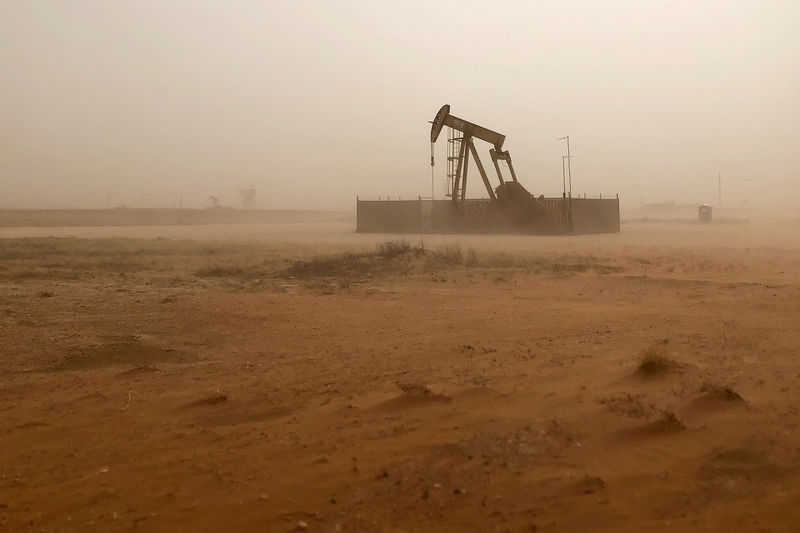 © Reuters. Pump jack lifts oil out of well during sandstorm in Midland
© Reuters. Pump jack lifts oil out of well during sandstorm in MidlandBy Ann Saphir
MIDLAND, Texas (Reuters) – In West Texas, rising oil prices are fueling a sharp economic upswing, lifting employment and pay to records, driving up spending at hotels, restaurants, and car dealerships, and raising the cost of housing and other essentials.
This parched patch of land, under which lie the largest oil-producing rock formations in the United States, is used to growth binges as well as the busts that always follow.
After a two-year crash, the price of crude () began to recover in 2016 and pierced $60 a barrel early this year. But oil is still far cheaper than at the peak of the previous eight-year boom that began in 2006 North Dakota’s Bakken oil patch and supercharged the city of Williston.
In the Permian basin, which stretches across West Texas and eastern New Mexico, the latest boom is being helped by advances in technology that allow drillers to extract much more from each acre.
“$60 is like the new $100,” said Dallas Fed economist Michael Plante in a mid-April interview.
Breakeven costs are now as little as $25 per barrel, according to the Dallas Fed’s most recent survey, so energy companies here no longer need $100 oil to make lots of money.
And Midland and its neighbor Odessa, the biggest towns for miles and the regional base for major oil producers in the Permian Basin, including Occidental Petroleum Corp (N:), Chevron Corp (N:), Apache Corp (N:) and Pioneer Natural Resources Co (N:), are feeling the surge.
“It is a full-fledged boom,” says Dale Redman, chief executive of Propetro, a Midland, Texas, firm that supplies heavyduty horsepower to drill sites, where energy companies coax crude from the ground with sand and water.
He has tripled his workforce since early 2016, drawing workers from towns and cities hundreds of miles away. Over half of his 1,200 employees make more than $100,000. “What it has done is raised wages for all these folks. But housing and the cost of living has gone up as well.”
To Midland Mayor Jerry Morales, “It’s a good story right now.” He says the city is trying to keep up with the drop in housing inventory and rise in rents by approving new apartment complexes and working with developers to put in water and sewer pipes.
But as owner of two restaurants in town, including Gerardo’s Casita, he sees the other side too.
“The biggest problem I face is low unemployment – finding workers,” he said in a phone interview, adding that he is increasing pay every six months to keep staff from leaving for other jobs, and he is hiking his menu prices as well.
JOBS JUMP, TRUCK SALES SURGE, RENTS RISE
Oil companies are drilling wells faster, and putting more wells on a single site, using technology to find the best angles and depths to get the most out of each layer of shale.
That has helped boost per-employee output by Texas oil and gas companies to an estimated $820,000, according to Waco, Texas-based economist Ray Perryman.
“Companies are making enough money to be able to afford to pay higher wages,” he said.
Unemployment was 3.2 percent in Odessa and 2.5 percent in Midland in February. Average weekly earnings in March hit records in both towns, which have a combined population of about 250,000. Sales tax receipts have soared.
“You have people that move in, you train them and then someone else offers them a job: there is constant raiding going on,” says Jeff Sparks, chief operating officer of family-owned Discovery Oil in Midland, who has only recently shifted to the more efficient and capital-intensive drilling techniques that have pushed per-barrel extraction costs down so steeply.
EXPANSION PLANS
At the Odessa car dealership the Sewell family has run since 1935, Colin Sewell sold 1,073 trucks in the first three months of this year, up from 670 last year. He is building a brand new service center on the outskirts of town.
Jason Tarulli, senior project manager at general contractor UEB, is using an out-of-town crew to build a downtown Odessa construction project he is overseeing, because local hiring would have been impossible.
His costs are rising; rent for a one bedroom in his building rose by more than $1,000 in less than a year, to $3,630.
Everyone who has lived here a while knows that the boom is not going to last, including Sondra Eoff, who is footing about half the $80 million bill for the downtown project, meant to help keep the town vibrant for the longrun and not just during boomtimes.
“When there’s an up, there’s a down,” she says.
Source: Investing.com




























